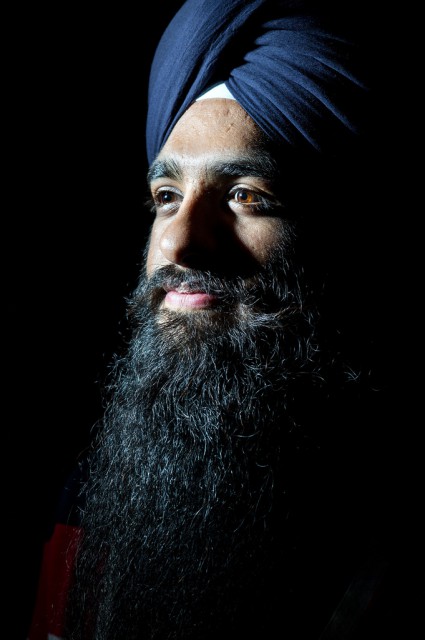
Written by Nicole Debarro
Photos by Ben Kamps and Amanda Peterson
According to study conducted this September by the Stanford Peace Innovation Lab, more than seventy percent of Americans can’t identify a practicing Sikh. Almost half of the population thinks Sikhism is a branch of Islam. And many associate a turban with Osama Bin Laden.
Twelve years following the tragic attacks on this country, Americans have continuously mistaken Sikhs for Muslims, terrorists, and even members of Al-Qaeda. These misconceptions seem to wrap around the turban. Like so many conflicts, this one seems based on a knowledge gap. As one of the five articles of faith, Sikh headwear represents equality and nobility, not to mention protects hair, considered to be one of God’s perfect creations.
Americans who assume that Sikh values can’t be American values might be surprised to learn they are quite parallel. Sikhs believe in creating and preserving community, while building strong and independent families and lifestyles. Aren’t those things what Americans want too? Originating in the Punjab region of northern India, this five-hundred-year-old religion encourages individualism while maintaining a balance with spirituality. Even so, the unique appearance and history of Sikhs have made them targets of hate crimes. This isn’t a recent development, yet Sikhs weren’t included in the F.B.I.’s hate crime statistics until August of this year. Following the horrific 2012 mass shooting of six Sikhs at a Wisconsin temple and the brutal beating of Dr. Prabhjot Singh, a Harlem professor, has the government finally taking notice.
In spite of such hate crimes, Sikh Americans are coming out on top, representing their community in technology, business, and less expected domains such as fashion. In part because of a fashion blog geared towards Sikh men, Singh Street Style, some are becoming style icons. They’re also posing in global fashion campaigns with Kenneth Cole and most recently GAP, featuring Waris Ahluwalia. In a world where image can be everything, Sikhs have adapted and established their identity. While rocking everything from Topman to BBC to Stussy, Sikhs have stuck to their roots, updated their turbans, and continue to represent their culture.
Below, a few young Sikhs chat about what it’s like growing up turban-ed in America. Gurmehar Dev, Gurjot Singh, and Mandeep Sethi agree that they definitely don’t have it easy in this society where they are often ignored or shunned, even as they strive to be their best self. Undeterred and driven by deep-rooted beliefs and strong sense of identity, they emphasize the importance of perseverance, compassion, and just being the best you can be.
Q+A
What was it like growing up Sikh in America?
Gurjot Singh: It was rough in the beginning. My brother and I were the only two Sikhs [in Vallejo]. Nobody had ever seen a turban in their life.

Anyone that had any type of head covering, whether it was a scarf or a turban or anything, they were always considered Saudi Arabian or Middle Eastern. We had to constantly break down barriers and all the perceptions people had.
Gurmehar Dev: When you’re a kid, you don’t see differences. You just play around. We were seen as geeky or nerdy. It took a while for the kids to realize I was different. It took a while for people who didn’t know me to understand that I was an American kid, I just have a different look.
Mandeep Sethi: When I was really young, I was definitely trying to fit in. I always got picked on, bullied. People would try to cut my hair in the classroom.
What is your definition of Sikhism?
GS: My definition of Sikhi is a very strict but simple living. You’re very devoted to your religion and you’re very aware of your surroundings at all times. In a sense that you’re one with nature, but you’re also one with people. We obviously want unlimited amounts of cash and biggest houses and the biggest cars, but at the end of the day, in our religion you’re taught that you come with nothing and you leave with nothing. You’re born naked and you die naked.

GD: Sikhi is living with love and peace with all and to accept. But don’t sell out. You stand up for when you’re right and for yourself.
MS: It’s kind of ingrained in who I am. But it’s also blended with my new understanding of the world through my own experiences as an individual. It still informs my day to day life. I’m
How would you describe your identity and your style?
GD: If you ask me how I define myself, first as Sikh, then as hip-hop. Those are my two major influences in life. I love heavy metal, so I’ll represent that in some ways. I like indie music, so I’ll represent that in some ways. I’m coming more into new, different styles. Now I have the confidence to wear boots. But I’m not gonna wear something because it’s in, it’s a fad, or it’s fashionable.
MS: I’m not really into brands. I wear Levi jeans, 514s. Mid to high-top kicks. I’m always rocking sneakers. I’ll wear a hoodie or a tee, depending on the city. I wear some stuff from Kalakari which is a blend of hip-hop culture and Indian culture. I wear some of the homies lines, like Universal BBoy Clothing. Hip-hop is my culture, so it’s also my style. Style comes from self-knowledge and I feel the more you know about yourself, the more you can distort that conversation with the rest of the world. Your style in general is almost your conversation with society. The more knowledge you have of “self” the more you’re able to specify your style or change your style. I’m definitely not into the death cult, 666 shit. Let’s spread the positivity!
What are the common misperceptions of Sikhs?

GS: Within the community, when they see someone with a turban or a beard, they tend to associate that person with religion. Obviously there’s exceptions to the rule. There’s often people who cut their hair but who are much more devoted. Over the years I’ve gotten a lot of good feedback from people. They’ll say certain words in punjabi to let me know they know what’s up. It brings a smile to my face because it means that people outside our religion are willing to gain some knowledge. It’s not the whole arrogance thing we had fifteen or twenty years ago.
MS: People always think you’re Muslim. I respectmy Muslim brothers and sisters. We’re all one. I don’t know what people’s misconceptions are because I create my own perceptions. hear more traditional Indian music. They also don’t expect my Californian accent. I sound like a surfer boy. And the typical stuff. Assuming you’re a Muslim or you’re a terrorist. Or putting those two things together.
How did 9/11 impact your life?
MS: I always had this sense of my identity and how it made people feel and the reactions it created. I think 9/11 solidified that and really made a distinction in our society. It was almost enforced on us. I’m not blaming other people about how they reacted. But it was enforced on the American population that “this image” of “these people” is evil, or threatening your safety. My energy is not in that area. I don’t think about it too much unless I’m forced to. I definitely address it with what I do. It’s all about resonanting that positive energy.
What do you wish people knew about Sikhs?
GS: People don’t understand the difference between Islam and Sikhi. They don’t understand the difference between the people. India is coming on the map because of their IT knowledge, so people are understanding slowly. I wish people would ask more questions so they’re more knowledgeable. Most Punjabis or most Sikhs are very willing to open up.
What is your goal as being Sikh?
GS: I want to be able to give back to our community. I think that the younger generations aren’t interested in religion. Sometimes there’s no difference. Even if they’re baptized, the way they act is very Western. It’s like which one are you? There’s a fine line between it. I just hope I can educate people in temples or in the newer generation to hold onto their values and beliefs.
GD: I’m trying to go back to our own language. I’m trying to go back into Punjabi culture. To fill the void we don’t get from living in America. My end goal, what I want to do is change the mentality of our society as it is. When I look at hip-hop, there was a time when the most popular hip-hop was the most conscious hip-hop. I want to basically take it back to what it was. I want to move people forward.






Arvinder singh • Dec 26, 2013 at 10:49 am
Excellent article addressing the relevant issues of the time. Very educational . Good job . Need more inter-cultural and inter-faith discussions and dialogue .
bhupinder sandhu • Dec 25, 2013 at 10:04 am
Well done youngsters..very mature answers !!! Keep ur chin up against some prejudices in USA u may face due to ur different looks……forgive ur country men quite a few ones are still confused between Obama and Osama!!!